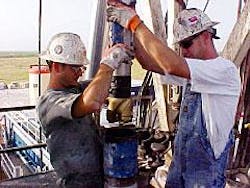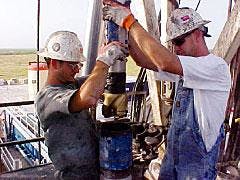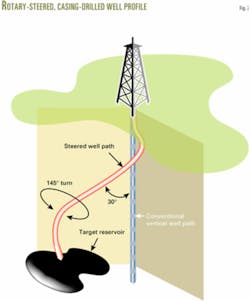ConocoPhillips achieves industry first with rotary-steered casing drilling
ConocoPhillips, Tesco Corp., and Schlumberger Ltd. successfully tested rotary-steerable casing drilling in South Texas, combining directional drilling technology with casing drilling.
"Each of these technologies is highly valuable to ConocoPhillips in its own right," said Helene Harding, Conoco- Phillips general manager for Lower 48 Gulf Coast. "The combination of them is extraordinarily powerful and has application around the globe."
Rotary-steerable directional drilling allows drillers to accurately direct the well path and safely drill around wellbores in highly congested areas, such as beneath a production platform. When combined with downhole logging-while-drilling tools, the bit can be precisely navigated through the reservoir, ensuring that the maximum amount of the highest quality reservoir is penetrated.
Casing drilling, a Tesco Corp. technology that has been field-proven in ConocoPhillips operations, utilizes casing rather than drill pipe to drill wells. Once the hole interval is drilled with the casing, the casing is cemented into place. Casing drilling operations virtually eliminate lost circulation and wellbore instability problems that lead to significant time and cost overruns.
null
Field program
To hold down costs while testing the technology, ConocoPhillips decided to experiment in an accessible location. The company's Lobo field, in Webb and Zapata counties just south of Laredo, Tex., was chosen.
ConocoPhillips started drilling vertically with casing in the Lobo field in July 2001. The company has since drilled 99 wells with casing in the field with about 90% vertical and 10% directional according to Kyle Fontenot, ConocoPhillips Gulf Coast onshore drilling manager. He said most wells are drilled with three strings (95/8-in. to 750 ft; 7-in. to about 8,000 ft; 41/2-in. to about 10,500 ft), complete surface to TD in 12-16 days using casing drilling.
ConocoPhillips began casing drilling with the Tesco 4 pilot rig, drilled five wells to prove the technology, then committed to build three casing drilling (Genesis series) rigs in Calgary which the company named Alpha, Beta, and Gamma. The rigs are all hydraulic— drawworks, mud pumps, and top drives. Fontenot said this produces higher torque and gives the driller more control than AC/DC rigs.
The rigs are designed for efficiently handling casing; they only run singles and are not built for multiple tripping (OGJ, Nov. 10, 2003, p. 55). "The big story about casing drilling is that we would save flat time by eliminating trips," Fontenot said, "but we actually saved time by reducing the number of problems."
Smear effect
Wells drilled with casing have smaller working annuli than wells drilled with pipe, and engineers were concerned about frictional pressures. In reality, Fontenot said, there was only one instance of stuck pipe. The big surprise, though, was the self-healing across a well-known lost-circulation zone. In one pipe-drilled well, they had experienced 100% losses and set cement plugs twice. Then they took a casing-drilling rig, drilled through the plug, experienced losses but kept going, and found that the losses from that zone decreased with depth, eventually sealing up and allowing them to reach TD and access reserves.
To explain this result, called the "smear" effect and previously noted by Conoco Inc. at Lobo (OGJ, Mar. 18, 2002, p. 64) and by Apache Corp.'s Dennis Bickford, ConocoPhillips analyzed drill cuttings. They found that the smaller annulus of a casing drilled well acted like a grist mill, producing a flat particle size distribution, from coarse to superfine particles. In comparison, cuttings from a pipe-drilled well were more typically skewed toward coarse (40%) and medium (30%) particle sizes. The casing drilled cuttings are thought to more efficiently seal off and plug lost circulation zones. As cuttings and filtercake are pressed into the wall they are smeared by casing rotation at high annular velocity, ultimately improving wellbore stability.
ConocoPhillips trouble cost dropped to about $26,000/well over the last 2 years of casing drilling at the Lobo field from about $92,000/well, a dramatic reduction, Fontenot told OGJ.
Lobo rotary steered drilling
The field produces from the Lower Cretaceous Lobo sandstone, and the drillers predominantly encounter shale and massive sandstone sequences. Hard pyrite streaks are found in the south part of the field, but there is not much casing drilling in the south because the rocks are significantly harder and the objectives deeper. This would increase the fatigue on the casing strings, particularly the connectors.
For ConocoPhillips rotary steered casing drilled wells, engineers drilled a 5,500-ft interval using 7-in. casing and Schlumberger's 43/4-in. PowerDrive rotary steerable system. The directional profile included a build to 30° of inclination and a drop back to 6° while making an azimuth change of 145° simultaneously (Fig. 2). Imagine an airplane peeling off to the right while diving.
Next steps
While rotary-steered casing drilling is not a panacea to solve all drilling problems, it's an important part of the ConocoPhillips toolkit, Fontenot said. He thinks it will be as well-accepted as drilling with pipe in the next 10-15 years.
"One of the primary barriers preventing the spread of casing drilling technology has been the lack of directional drilling experience," said Fontenot. "The success of this project makes it a whole new ballgame." He told OGJ that the 100th Lobo well drilled with casing would be spudded in January 2005. This will be the company's third rotary-steered well using casing drilling. Overall, Conoco- Phillips will drill about 56 wells at Lobo in 2005, of which 16-18 will be drilled with casing using the Alpha rig.
Joe Leone, ConocoPhillips vice president for upstream technology added, "our next challenge is to apply this in other areas around the world to fully leverage the value that these technologies can bring to ConocoPhillips."
The company has already tried vertical casing drilling off Indonesia in 2003, using Weatherford's system with drillable bits. ConocoPhillips may also combine their rotary steered casing drilling experience with their research work in close tolerance liner drilling to work off pads in Alaska or offshore platforms in the North Sea.


